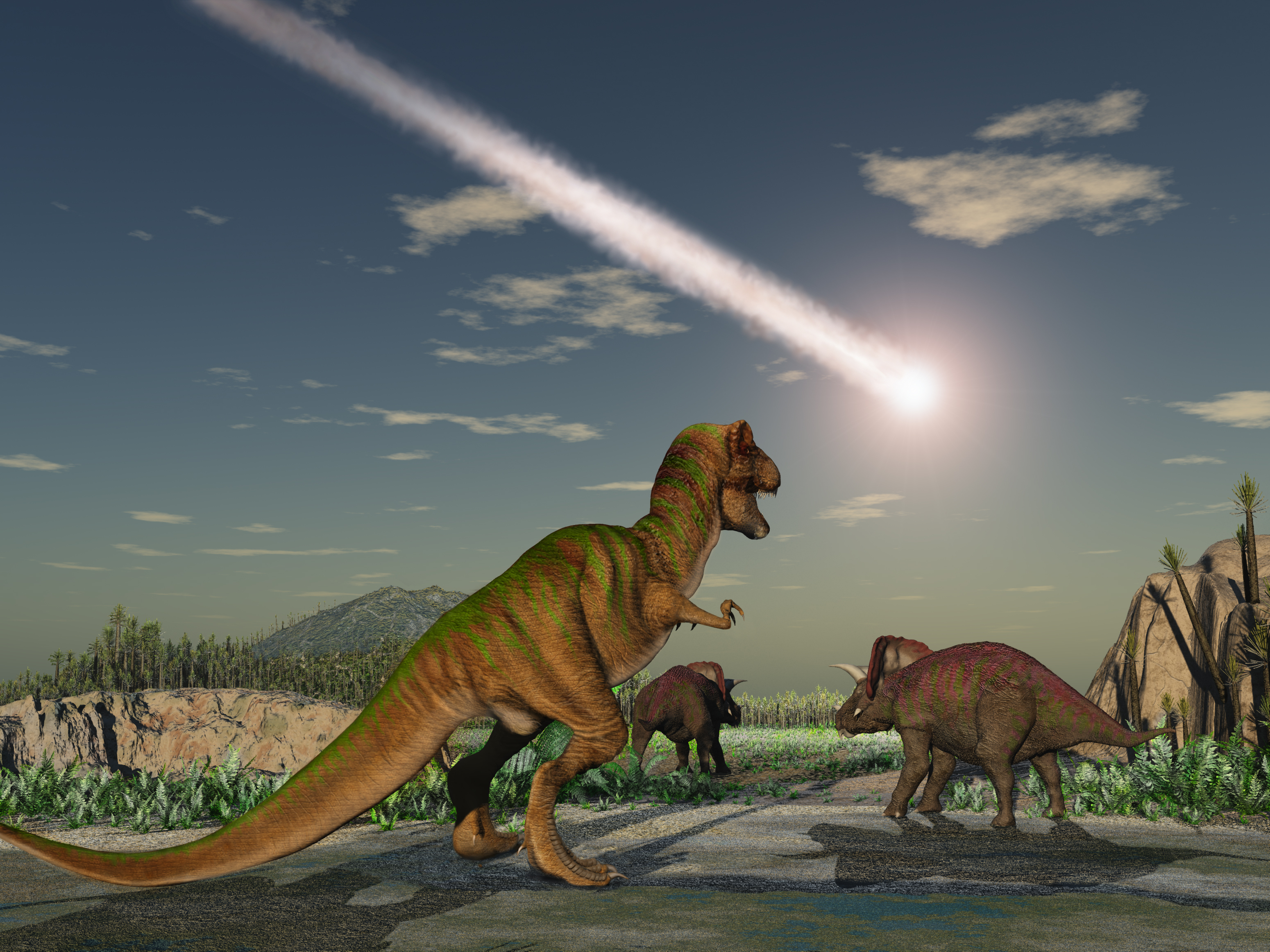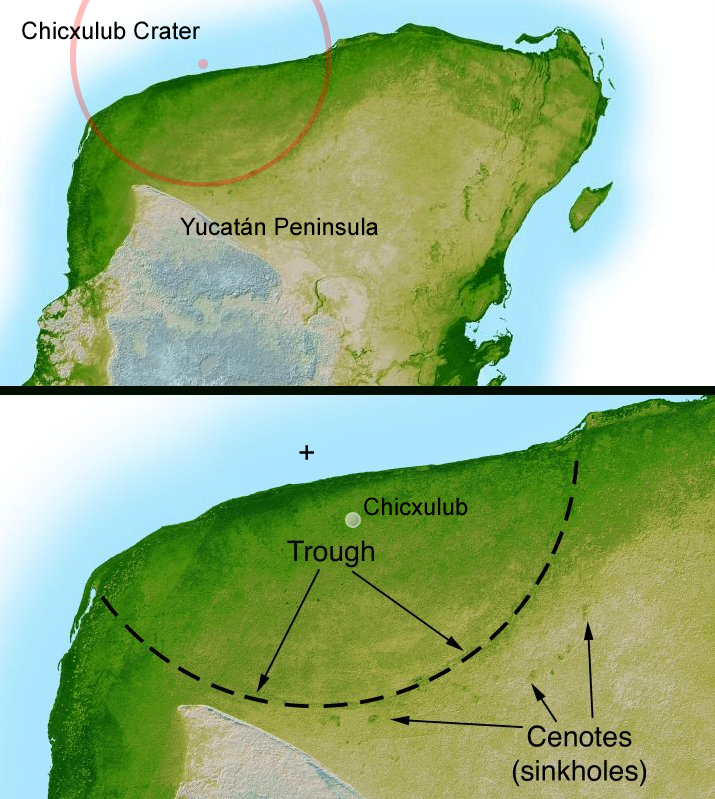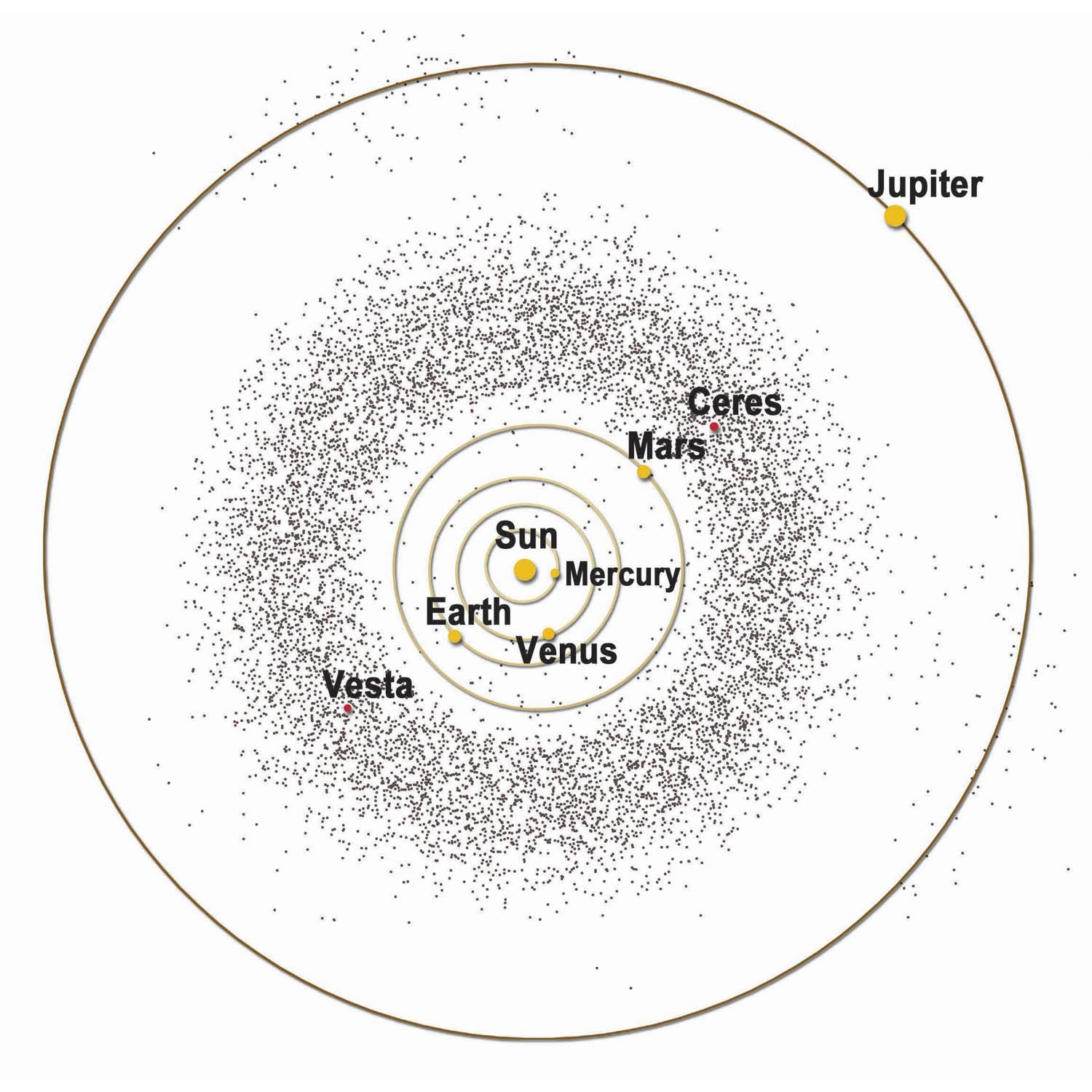Asteroid that killed the dinosaurs: Likely origin and what we know about the famous space rock
Scientists continue to take this mass murderer's measure.

Sixty-six million years ago, a mountain-size asteroid slammed into Earth just off the coast of Mexico's Yucatán Peninsula, dooming the dinosaurs and leading to their extinction.
The collision was cataclysmic, triggering tsunamis that swamped vast swaths of coastline and firestorms that may have raged across the entire globe. The impact also blasted huge amounts of dust and vaporized rock into the air, which, along with the soot from all those fires, blocked the sun for long stretches.
To make matters worse, much of that vaporized rock was rich in sulfur, generating sulfuric acid aerosols that rained back down on Earth and acidified the oceans.
Related: Potentially dangerous asteroids (images)
These and other associated haymakers wiped out three-quarters of all species on Earth, including the non-avian dinosaurs, in an event known as the K-T mass extinction. (Extensive volcanism in the Deccan Traps region of Western India and long-term climate change likely contributed to the carnage, experts say, but the cosmic impact was the killing blow.)
The asteroid that did all this damage is long gone, almost entirely destroyed in its kamikaze strike. But scientists have been able to take its measure to some extent over the past few decades. Here's what we know about the famous dino-killer.
Dino-killing asteroid: Was it an asteroid or comet?
A team led by Nobel Prize-winning physicist Luis Alvarez proposed the death-by-above hypothesis for the K-T extinction in 1980, after noticing that 66-million-year old clays around the globe sport far more of the rare metal iridium than the layers above and below them.
The iridium was likely delivered by an impactor that hit Earth at that time, the scientists reasoned. A decade later, another research team identified the place where the space rock hit, spotting a buried crater about 90 miles (150 kilometers) wide straddling the Yucatán Peninsula and the Caribbean Sea. Further investigation revealed that the crater, named Chicxulub, formed 66 million years ago, and that iridium levels seem to decrease at greater distances from its center.
What type of object slammed into Earth that fateful day 66 million years ago? Alvarez and his team suspected it was an asteroid, and that remains the general consensus.
It's not unanimous, however; some researchers think a comet blasted out Chicxulub Crater. In a February 2021 paper, for example, Harvard astrophysicists Amir Siraj and Avi Loeb argued that comets are the best match with the geochemical evidence, which indicates that the impactor had a carbonaceous chondrite composition. (Carbonaceous chondrites are a relatively rare type of dark, primitive meteorite containing high levels of carbon and minerals that were altered by water, among other characteristics.)
Siraj and Loeb also calculated that about one-fifth of all long-period comets — icy wanderers that take more than 200 years to complete one orbit — break apart when they pass close to the sun, generating lots of fragments.
"This population could increase the impact rate of long-period comets capable of producing Chicxulub impact events by an order of magnitude," Siraj and Loeb wrote in the study, which was published in the journal Scientific Reports. "This new rate would be consistent with the age of the Chicxulub impact crater, thereby providing a satisfactory explanation for the origin of the impactor."
Their paper spawned a response by Arizona State University researcher Steve Desch and colleagues. Desch and his team pushed back against Siraj and Loeb's geochemical arguments, saying that comets match only with a certain class of carbonaceous chondrite known as CI — and that's not the fingerprint the impactor left behind.
"In fact, careful consideration of the geochemical evidence strongly favors a CM or CR carbonaceous chondrite and rules out a cometary impactor," Desch et al. wrote in their paper, which was published in June 2021 in the journal Astronomy & Geophysics.
Siraj and Loeb have written a response to that response, contributing to a debate that has been going on for 40 years and may continue for decades into the future. That being said, Siraj and Loeb are in the minority here. "The broad consensus is in favor of an asteroid impactor," Desch and his team wrote in their paper.
Related: Photos of asteroids in deep space
Dino-killing asteroid: How big was it?

The dimensions of Chicxulub Crater — about 90 miles wide by 12 miles (20 km) deep — give us a rough idea of the impactor's size.
For example, Siraj and Loeb calculated that the incoming object was likely about 4.3 miles (7 km) wide. But that's probably not the number you're most familiar with, because it assumes the impactor was a piece of a long-period comet.
Asteroids in the main belt between Mars and Jupiter orbit more slowly than long-period comets, so they must be bigger to gouge out a hole in the Earth the size of Chicxulub. Folks in the asteroid camp think the impactor was about 6.2 miles (10 km) in diameter.
Asteroid or comet fragment, the space rock was big enough to spur one of Earth's six known mass extinctions. (Humanity is currently living through, and is primarily responsible for, the sixth one.)
Dino-killing asteroid: Where did it come from?

In 2007, a team of scientists led by Bill Bottke of the Southwest Research Institute (SwRI) in Colorado proposed an origin story for the dino-killing asteroid — a massive collision in the innermost portion of the main asteroid belt about 160 million years ago, which broke apart a 106-mile-wide (170 km) space rock called Baptistina.
"Fragments produced by the collision were slowly delivered by dynamical processes to orbits where they could strike the terrestrial planets," the researchers wrote in the 2007 study, which was published in the journal Nature. "We find that this asteroid shower is the most likely source (>90% probability) of the Chicxulub impactor that produced the Cretaceous-Tertiary (K-T) mass extinction event 65 [million years] ago." (The date of the impact and extinction has recently been revised, to 66 million years ago.)
In 2011, however, observations by NASA's Wide-field Infrared Survey Explorer spacecraft more or less ruled out the "Baptistina" hypothesis by showing that the in-space collision likely occurred just 80 million years ago or so. That didn't give the newly spawned fragments enough time to move into a position from which one of them could be gravitationally nudged onto an Earth-crossing trajectory, researchers said.
We still don't know exactly where the dino-killing asteroid came from; its parent body remains a mystery. But a 2021 study narrows its native neighborhood down a bit.
In that paper, SwRI scientists David Nesvorný, Bottke and Simone Marchi used computer models to better understand the asteroid population and powerful impacts like the one that caused the K-T mass extinction. They determined that the dinosaur killer was an asteroid that formerly resided in the main belt, likely in its outer portions.
Nesvorný and his team also calculated that about half of all Earth-impacting objects more than 3 miles (5 km) wide are dark carbonaceous asteroids. And they found that objects at least 6 miles wide probably hit our planet just once every 250 million to 500 million years. So — fingers crossed! — another one shouldn't head our way for a long time.
Additional resources:
- Read about how the asteroid strike caused the K-T mass extinction (the mechanisms involved).
- Learn more about the impact site, Chicxulub Crater.
- Get an overview of Earth's six mass extinctions.
Mike Wall is the author of "Out There" (Grand Central Publishing, 2018; illustrated by Karl Tate), a book about the search for alien life. Follow him on Twitter @michaeldwall. Follow us on Twitter @Spacedotcom or on Facebook.
Join our Space Forums to keep talking space on the latest missions, night sky and more! And if you have a news tip, correction or comment, let us know at: community@space.com.
Get the Space.com Newsletter
Breaking space news, the latest updates on rocket launches, skywatching events and more!

Michael Wall is a Senior Space Writer with Space.com and joined the team in 2010. He primarily covers exoplanets, spaceflight and military space, but has been known to dabble in the space art beat. His book about the search for alien life, "Out There," was published on Nov. 13, 2018. Before becoming a science writer, Michael worked as a herpetologist and wildlife biologist. He has a Ph.D. in evolutionary biology from the University of Sydney, Australia, a bachelor's degree from the University of Arizona, and a graduate certificate in science writing from the University of California, Santa Cruz. To find out what his latest project is, you can follow Michael on Twitter.










